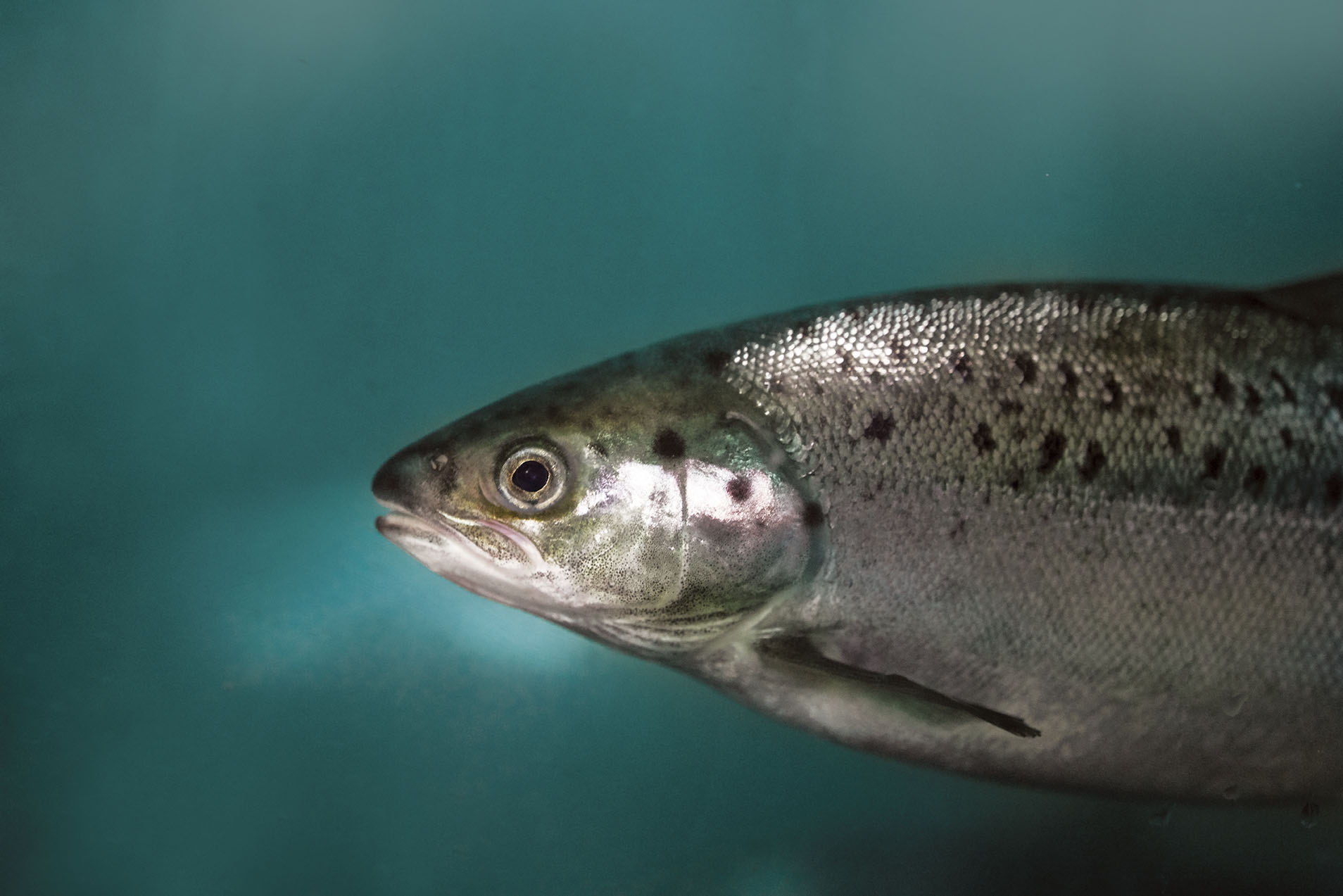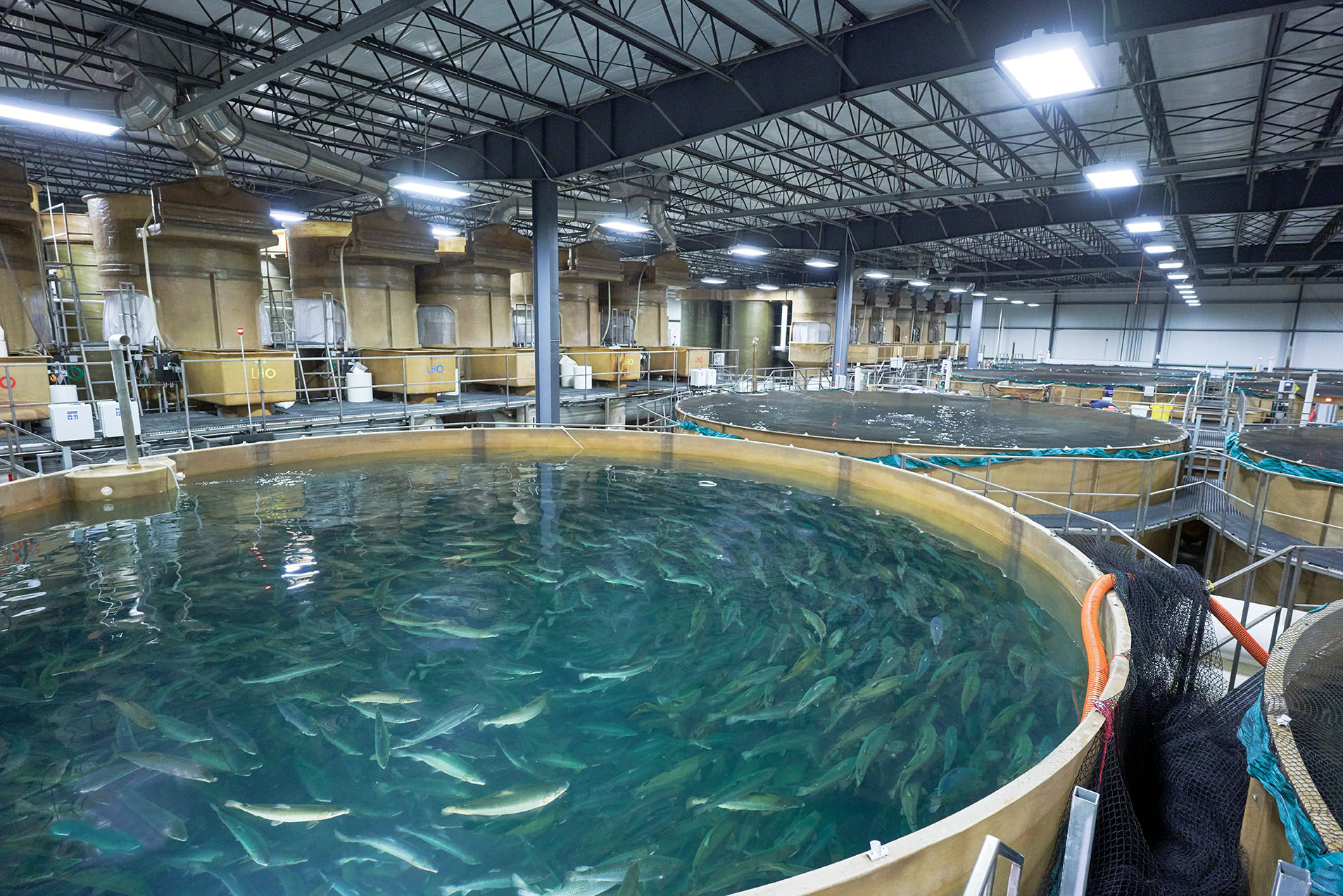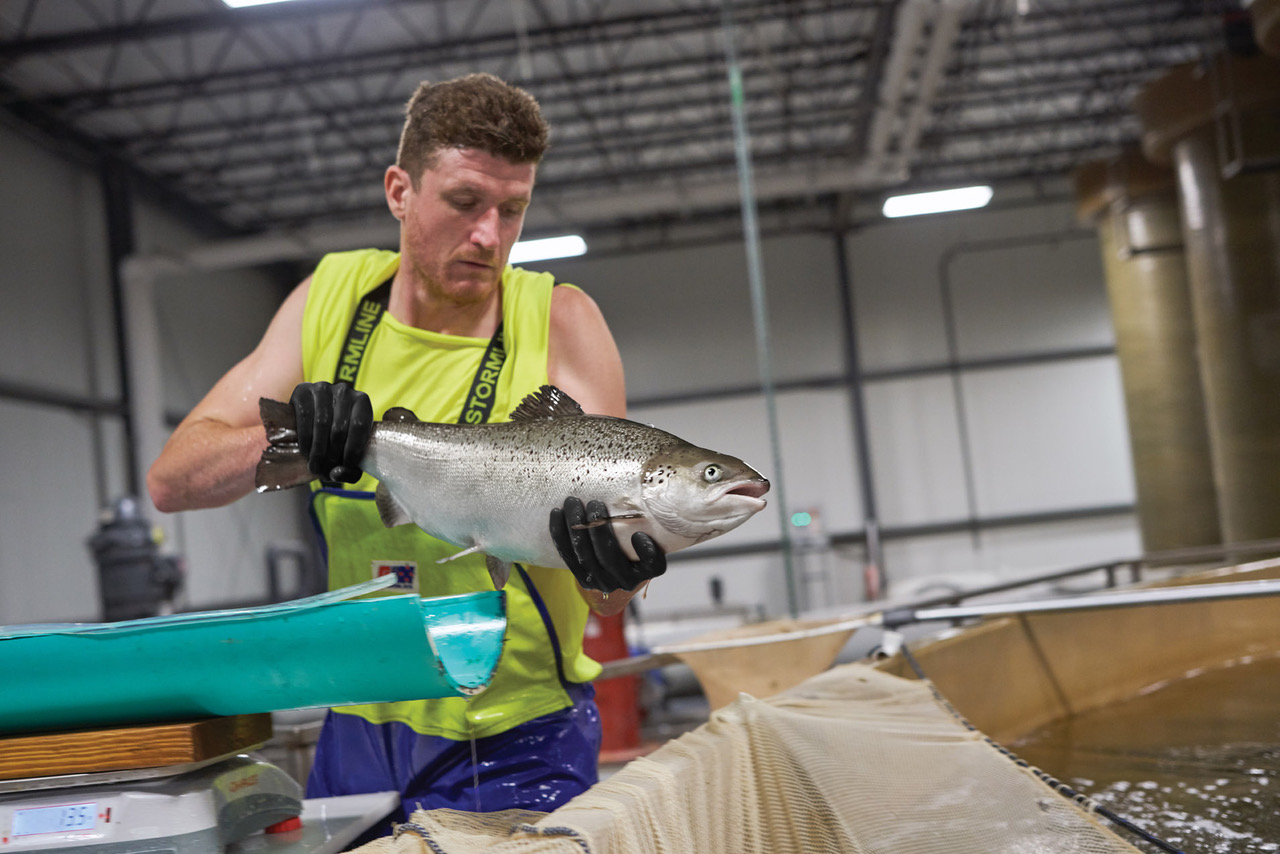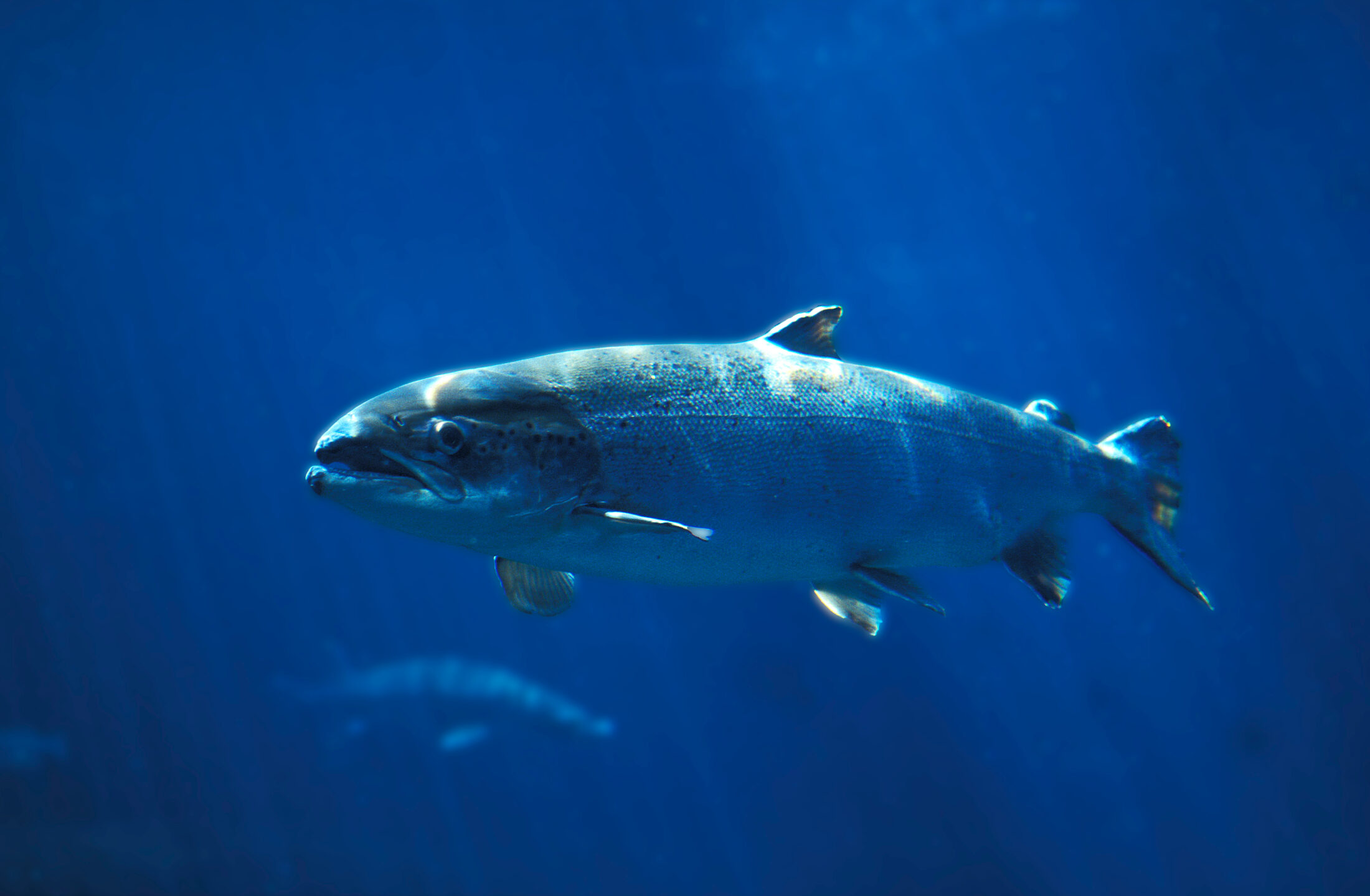
Canada’s fossil fuel companies win battle against climate transparency
Financial regulators hit pause this week on a years-long effort to force corporations to be...
This is the second part of The Narwhal’s three-part series on the future of sustainable salmon.
On Prince Edward Island, anchored between Rollo Bay and a sea of potato fields, the first genetically engineered salmon raised in Canada for food are swimming in tanks.
Grown in a land-based containment system, they look like any other Atlantic salmon: silvery, pale-bellied and speckled on top. But hidden in their DNA is a growth hormone gene from chinook salmon — spliced into genetic coding from ocean pout, an eel-like fish — that allows them to grow to full size at twice the speed.
When the salmon are harvested early in the new year, they will be shipped to seafood distributors, finding their way to restaurants, hotels, hospitals and grocery stores. Yet Canadians munching on salmon tacos or salmon au gratin won’t have a clue they are eating the world’s first genetically modified food animal. Unlike the European Union and the United States, Canada does not require GMO foods to be labelled — and the fast-growing fish are no exception.
AquaBounty Technologies, the U.S.-based biotechnology company pioneering the genetically engineered salmon, says it is “combining the goodness of nature with the power of science and technology.”
“We believe savouring your favourite fish and helping save the planet should be one and the same,” the company’s website says. “And that’s why we believe in using science and technology to help solve global problems, like food scarcity and climate change.”
AquaBounty markets the salmon as disease- and antibiotic-free, saying its product comes with a reduced carbon footprint and no risk of pollution of marine ecosystems compared to traditional sea-cage farming.
But others have a wildly different view of the AquaBounty salmon, grown with technology called AquAdvantage, a name that would be at home on the pages of a dystopian Margaret Atwood novel.
“It’s Frankenfish,” says Charlie Sark, a member of the Mi’kmaq First Nations and professor in the school of climate change and adaptation at the University of P.E.I. “It’s science fiction. Just because we’ve created a machine that can splice genes together, does it mean we should do it?”
Even if the engineered salmon are raised only in land-based containment systems, Sark and others say human error could lead to the genetic contamination of threatened wild salmon stocks, underscoring that the federal government’s behind-closed-doors approval of AquAdvantage fish has far reaching consequences for Indigenous Rights and nature.
“Salmon are sacred,” Sark says in an interview. “You just can’t change the genetics of an animal that Indigenous peoples have used for thousands of years without first consulting them.”

An AquaBounty genetically engineered Atlantic farmed salmon photographed in July, 2020, at a fish farm facility on Prince Edward Island. Photo: AquaBounty
Genetically engineered salmon eggs were approved for land-based production in Canada in 2013, when Stephen Harper’s Conservatives were in power.
The government only permitted one company, AquaBounty, to produce the eggs — and only at a P.E.I. facility. Today, the Rollo Bay operation is also the sole supplier of genetically engineered Atlantic salmon eggs for the company’s land-based salmon farm in Albany, Indiana, which planned to send salmon to market late this year or early in 2021.
The eggs had their genesis in a laboratory at Newfoundland’s Memorial University, where scientist Garth Fletcher and his colleagues isolated the anti-freeze gene in ocean pout, which can survive year-round in near-freezing waters.
They replaced the coding region in the middle of the anti-freeze gene — unlike in other fish, the gene doesn’t turn off seasonally — with the growth hormone gene from chinook salmon (the scientists used chinook because it was readily available at the time).
Then the team injected the new coding sequence into Atlantic salmon eggs. “It took a while for us not to kill the eggs,” Fletcher, head of the ocean sciences department, says in an interview.
After tweaking their technique, Fletcher and his colleagues were excited to discover the genetic trait was passed on through breeding. And then came another exciting finding for the team; the rapidly-growing salmon reached maturity in just under two years, compared to three.

Scientist Garth Fletcher is head of the ocean sciences department at Memorial University and worked with colleagues to develop the AquAdvantage technology now being used in AquaBounty salmon farms. Photo: David Howells / Memorial University
“It was an enormous change in the rate of growth,” Fletcher says, noting that cross-breeding has further enhanced growth speed. “It’s the same with any crop, if you can replant land or get another set of fish earlier than normal, you have increased productivity.”
By comparison, regular Atlantic salmon grown in optimal conditions in Atlantic Sapphire’s land-based facility in Florida reach maturity in 22 to 24 months.
Fletcher doesn’t consider the genetically modified salmon to be much different than new fruit and vegetable products created through cross-breeding, such as the Cosmic Crisp apple that has a longer shelf life or Depurple, a purple cauliflower sweeter than the typical white variety.
He says food companies are “getting rid of everything that doesn’t meet their standards in terms of a commercial product. You’re actually changing nature … all these kinds of things are unnatural if you want to call it that.”
“There is a problem with food production in the world. I know some of it is political, but if I have an idea or a technique that might be able to help with food production then I’m all for it, as a scientist.”
The need for protein is growing in tandem with the world’s rising population, expected to top nine billion before 2025. Salmon, which have Omega-3 fatty acids and are a good source of minerals and vitamins, are increasingly in demand. But the on-going decline of wild stocks is constricting supply. And as tighter regulations make open net pen salmon farming more challenging, investors — including AquaBounty — are turning to land-based salmon farming.

AquaBounty farmed salmon grown in containment tanks. The company says the fish are reared without the need for antibiotics and are free from parasites. Photo: AquaBounty
Fletcher’s team, which was funded by the Natural Sciences and Engineering Research Council, partnered with a small company that morphed into AquaBounty, largely bankrolled by billionaire biotech entrepreneur Randall Kirk.
When AquaBounty set up its research and development facility on Prince Edward Island to produce the genetically modified eggs, the federal government did not permit the fish to be grown to adult size, so eggs were shipped to an AquaBounty research and development facility in Panama.
Once Health Canada approved the salmon for consumption in 2016, Ottawa allowed AquAdvantage salmon grown in the Panama facility to be sold to unwitting Canadian consumers.
The first batch of genetically modified Atlantic salmon from the Panama facility arrived at Montreal’s Pierre Elliot Trudeau airport in 2017, according to import documents obtained by the Quebec food watchdog group Vigilance OGM. More than 4.5 tonnes of AquAdvantage salmon subsequently flowed, unlabelled and untraceable, into Canada’s food supply.

Peter Bowyer, AquaBounty farm manager, oversees containment systems where the salmon are grown. Photo: AquaBounty
“There is no mandatory labelling for consumers in the grocery stores and there’s very little transparency, and yet we find ourselves in the position of eating the world’s first genetically engineered animal,” says Lucy Sharratt, coordinator of the Canadian Biotechnology Action Network, which represents 16 groups working on issues related to genetic engineering in food and farming.
Sharratt, who has an extensive background working as a researcher and campaigner for groups involved in genetic engineering and global justice issues, says the lack of transparency extends to Ottawa’s decision-making process for approving the engineered salmon.
Starting in 2019, following a federal risk assessment, Ottawa allowed the salmon to be raised to maturity at the Rollo Bay facility, which also produces conventional salmon eggs, triggering concerns about a potential mix-up.
The biotechnology action network has tried to obtain information about the “behind closed door” approval process, Sharratt says, but information AquaBounty submitted to the government is confidential and the network’s questions haven’t been satisfactorily answered.
“The information that’s used to decide the safety of genetically engineered food is submitted by the companies that want approval,” she says. “Very little of that information is publicly available. Very little is peer-reviewed.”
The absence of information is all the more concerning, she says, because of the broad — and also unknown — implications of tampering with nature and the precedents it sets.
“What we have here is potentially a very profound shift in the way we view food and where it comes from. Do fish come from the ocean, do they come from our rivers, do they come from an ecosystem? Or do they come from an on land factory? … What decisions are we making that further threaten the future of wild salmon?”

Lucy Sharratt, coordinator of the Canadian Biotechnology Action Network, is concerned about the consequences of genetically modified food. Photo: Lucy Sharratt
Nature Canada senior advisor Mark Butler says the federal government has opened a Pandora’s box by approving the development and sale of genetically engineered salmon and eggs without a robust public discussion about the potential consequences.
“You could say, ‘what’s wrong with pink blue jays or blue cardinals?’ We are now applying engineering to the genome to the very blueprint of life. It has big implications and this technology is racing along. I think it gets at the whole issue of what’s wild and what’s nature, and where do humans stop and where does nature start?”
“Do we have the right to edit the genome of a wild species from an Indigenous perspective? This raises some pretty fundamental questions and challenges.”
Salmon are sacred to Indigenous peoples like the Mi’kmaq, and are part and parcel of food security and food sovereignty, Sark points out. They are also an integral part of cultures through ceremony, song, oral history and art. As wild stocks decline, it has a reverberating impact on the physical and spiritual health of Indigenous communities.
Sark says Indigenous peoples should have been properly consulted and Ottawa should have obtained their free, prior and informed consent before approving genetically engineered salmon.
“As a Mi’kmaq I have a right to food, I have a right to fish lobster, I have an inherent right to access and harvest fish out of the ocean or out of the streams, the brooks, the rivers, the lakes. The Canadian government cannot extinguish that right.”
He wonders what would happen if he caught an Atlantic salmon that somehow contained DNA owned by AquaBounty.
“I’m holding a salmon that I’ve caught in my traditional waters, that my ancestors have used for thousands of years, but because it’s an escaped salmon or an inbred salmon from this genetically modified [organism], is it illegal for me to hold that fish and eat it without paying AquaBounty?” Sark asks. “Where does this end?”
Kris Hunter of the Atlantic Salmon Federation, a science and advocacy organization dedicated to conserving and restoring wild Atlantic salmon, says genetically engineered salmon could be an ecological disaster for wild salmon, especially if rules change and they become the fish of choice for the farmed salmon industry.
” … if these animals were to get out … what impact that would have on the wild fishery?”
He points to the escape of hundreds of thousands of Atlantic salmon from fish farms in B.C. and Washington state. In December 2019, more than 20,000 salmon escaped from a Mowi fish farm near Port Hardy on northern Vancouver Island, while more than 160,000 Atlantic salmon escaped from a Cooke Aquaculture fish farm in Washington State in 2018, leading to a state ban on raising Atlantic salmon in open net pens.
Some escaped Atlantic salmon have been found in the salmon-bearing Fraser River, heightening worries that they will compete for food and habitat given evidence that the farmed fish can naturally reproduce.
“Our concern would be if these animals were to get out and what impact that would have on the wild fishery? The wild fishery is not doing well right now.”
Karen Wristen, executive director of Living Oceans Society, a non-profit organization dedicated to protecting Canada’s oceans, is uneasy about how the fast-growing genetically modified salmon might behave in the wild, possibly mating with endangered salmon populations, preying on wild juvenile salmon and outcompeting wild salmon and other ocean creatures for food. “You can picture it wanting to hoover up everything in its path.”
And if the salmon farming industry transitions to land-based containment systems, Wristen and Butler say there will be pressure on companies from investors to embrace genetically engineered salmon, to keep costs in line with competitors.

A wild Atlantic salmon in the waters near Quebec. Canada’s wild Atlantic salmon populations have dramatically declined in recent decades. Photo: Shutterstock
The U.S. Food and Drug Administration approved AquaBounty’s genetically engineered salmon in 2010, on the condition that the salmon be sterile. Sterility is achieved through a process that creates a condition called triploidy — the salmon have three chromosome sets instead of two — that is between 99.5 and 99.8 per cent effective.
“It’s an important barrier, but not a fool proof barrier,” Butler notes. For every 10,000 salmon the company produces, between 20 and 50 fish will be fertile.
Hunter, director of programs for P.E.I. and Nova Scotia, says the Atlantic Salmon Federation has met with AquaBounty and the company appears to be doing due diligence to make sure the genetically engineered salmon don’t escape.
“Our concern is an accident. A truck goes off the road carrying these things as it’s crossing a salmon river, and the next thing you know these fish are out and they’re breeding amongst other fish populations and causing untold damage.”
Genetically engineered salmon eggs could also get mixed up with the regular salmon eggs harvested at the same AquaBounty facility and end up at an open net pen farm, Hunter points out. The company isn’t currently permitted to sell the eggs to open net pen operations in Canada, but Hunter says that could always change.
“Systems fail and accidents happen. Once the genie is out of the bottle you can’t put it back in … We think this is a very risky enterprise. And we don’t necessarily see the benefit.”
In an emailed response to questions from The Narwhal, AquaBounty president and CEO Sylvia Wulf said the company does not plan to supply AquAdvantage salmon eggs to open net pen farms and will produce the genetically modified salmon in its own land-based facilities.
AquaBounty’s land-based farm in Albany, Indiana, plans to send its first salmon to market later this year or early next year, depending on demand, which has been dampened by the COVID-19 pandemic. The company also plans to build a much larger facility in Mayfield, Kentucky, that will produce 10,000 metric tonnes of salmon a year, about eight times more than its Indiana plant.
Wulf says all of the company’s market production salmon are female and sterile, which means they cannot mate with each other or with other Atlantic salmon. In addition to the biological barrier, she says the company’s land-based containment systems are equipped with physical barriers, including screens, grates, netting, pumps and chemical disinfection, to prevent escape of salmon at all life stages, from eggs to full size.

AquaBounty’s P.E.I. fish farm. The facility is located in farmland where potatoes and soybeans grow and is about one kilometre away from the Northumberland strait. The facility’s proximity to streams and ocean water is cause for concern among critics. Photo: Leo Broderick
And AquaBounty will address egg mix-up concerns by ensuring that eggs are from conventional salmon before sending them out to farms, says Wulf, who declined a telephone interview.
Sark calls the secretive federal approval process of AquAdvantage salmon a “coup d’etat,” noting that the Canadian Environmental Protection Act, which regulates genetically modified organisms, hasn’t been updated for 20 years and doesn’t have the bandwidth to consider genetically modified salmon.
The act, according to Butler, is a “really complicated and obtuse piece of legislation,” while Wristen says as challenging to decipher as the often maligned income tax act.
“Our act is outdated,” Sark says, “and I would say extremely colonial in its essence that it can’t consider genetic modification of animals that Indigenous people to a large extent still rely on, or use for ceremonial purposes, which is a matter of our sovereignty. Using the animals for sustenance is a matter of food security. The role it plays in ceremony and in culture and identity is a matter of our food sovereignty.”
“This is a first in the world. You’re approving it to go ahead. And your legislation is inadequate.”
In the September Speech from the Throne, the Trudeau government pledged to update the environmental protection act. But Butler says senior officials in Environment Canada have indicated the changes will be minor, much to the dismay of those considering the impacts of genetically engineered salmon.
“This is a first in the world,” Sark says. “You’re approving it to go ahead. And your legislation is inadequate and you’re not considering making it adequate? Wait a second. Isn’t that your job? Isn’t that the role of government … to make sure our health and security is looked after? Isn’t that the ultimate number one goal when you sit there in Parliament… to look after our interests, not the economic interests of one company?”
In 2016, the Centre for Food Safety and the environmental law organization EarthJustice sued the U.S. Food and Drug Administration for approving genetically engineered salmon, acting on behalf of a broad coalition of environmental, consumer, commercial and recreational fishing organizations and the Quinault Indian Nation.
In early November, a U.S. federal court judge ruled the Food and Drug Administration failed to analyze the risks to endangered salmon from an escape and to take into account the full extent of plans to grow the genetically modified salmon in the U.S. and around the world.
The court also ruled that the Food and Drug Administration’s conclusion that genetically engineered salmon could have no possible effect on endangered wild Atlantic salmon stocks was wrong, and violated the U.S. Endangered Species Act.
While Judge Vincent Chhabria found the current risk to wild salmon stocks is low, he said the possibility of exposure increases with each new facility built.
“Understanding the harm that could result from that exposure — and having an explanation of it on record — will only become more important,” the judge said, ordering the FDA to go back to the drawing board to sketch out a full explanation of potential environmental consequences.
The decision, watched closely by Nature Canada, the Atlantic Salmon Federation and other groups in Canada, was celebrated by Earthjustice and its clients. “Our efforts should be focused on saving the wild salmon populations that we already have — not manufacturing new species that pose yet another threat to their survival,” Earthjustice managing attorney Steve Mashuda said in a media statement.
Earthjustice cited studies showing there is a high risk for genetically engineered organisms to escape into the natural environment, and that genetically engineered salmon can crossbreed with native fish. Genetically engineered crops commonly cross-pollinate or establish themselves in nearby fields or the wild — a process known as transgenic contamination. The contamination episodes have cost American farmers billions of dollars over the past decade, Earthjustice noted.
“In wild organisms like fish, it would be even more damaging.”
Wulf says the company is disappointed with some of the judge’s conclusions but remains confident “in the robust scientific studies and review” that led to the 2015 FDA approval of AquaBounty salmon.
“This case did not call into question FDA’s approval regarding the health and safety of our AquAdvantage salmon,” she wrote in her email. “The focus of this decision was on the potential environmental impacts, and the judge confirmed the ‘low’ threat to the environment of our salmon.”
The decision will not impact operations at the Prince Edward Island or Indiana facilities, according to Wulf, who says the company will work with the FDA on next steps and will “continue to evaluate the legal decision.”
“The future of our domestic and global food supply will depend on innovation and technology and AquaBounty remains steadfast in our commitment to leading that charge.”
Butler, who supports land-based salmon farming operations, has a piece of advice for AquaBounty: “Skip the genetically engineered salmon and just raise normal fish using the best techniques and the best genetic strains — and we won’t have a problem with your operation,” he says.
“Most Canadians, if they had to assess the risks and benefits, would just say, ‘Give me a normal salmon.’ ”
Get the inside scoop on The Narwhal’s environment and climate reporting by signing up for our free newsletter. When I visited my reserve, Moose Factory,...
Continue reading
Financial regulators hit pause this week on a years-long effort to force corporations to be...

The Conservative and Liberal parties diverge sharply on Indigenous issues. Here’s what that could mean...

After a series of cuts to the once gold-standard legislation, the Doug Ford government is...

